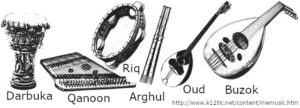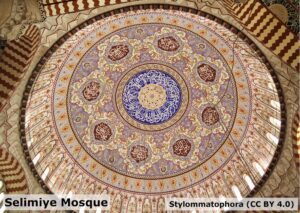Let’s talk about belly dance music. Being able to pick apart and understand belly dance music makes it easier to interpret it as a dancer. In this post, you will learn how to listen to the rich texture of belly dance music. “How the tempo, melodic, and harmonic materials are combined in a composition, thus determining the overall quality of the sound in a piece” (Wikipedia: “Texture (music)”). Like a layer cake, music is made up of several constituent layers. When combined, they create a complex and coherent sound texture (or a delicious cake). Once you can hear the musical layers, you can move back and forth between them as you dance to the music. This gives your dance an extra richness.
Introduction
In this blog post, I focus on ‘Eastern’ music, since belly dance originates from the Middle East. Many of us aren’t very familiar with this style of music. Though most concepts from this blog post are applicable to many other styles of music that belly dance may be performed to.
In Middle Eastern music, the layers are typically the rhythm, ostinato, melody, and decorations. We’ll be looking at each of these in more detail. Hearing these enable you to listen (and therefore dance) more deeply to Middle Eastern music. For those of you more familiar with Western music, you may notice that harmony is missing from my list of layers. Western music is awash with harmony: simultaneous, different musical pitches. In Middle Eastern music, a single melody is typically performed by multiple voices with no accompanying harmony. In that case, the depth comes from the texture. This could be the solo or group of instruments or voices used. Or the uniqueness of the execution of the melody by each musician. The resulting sound is called heterophony – ‘different voices’ (Baba Yaga Music: “Arabic Music for Western Musicians”).
Rhythm
The foundation of our musical layer cake is the pulse. Does the music have a beat you can clap along to? That’s the pulse. Most belly dance music does. Unless it’s a taqsim: an improvisation in free rhythm. Taqsims can be commonly found as an introduction or middle section of a classical belly dance song. The tempo is the pace of the musical pulse. Is it fast or slow, or somewhere in between? Does it vary during the song? The meter tells us how many pulses are in each bar, with the first pulse in a bar being the strongest. Typically dance music has 2, 4, or 8 pulses in a bar. In a piece of music, you should hear this strong first pulse and be able to count out the meter. For example, four beats to a bar is: One-two-three-four, One-two-three-four, One-two-three-four, …. On top off all this, is the rhythmic mode (iqa) in Middle Eastern music. The rhythmic mode deserves a future blog post of its own. Suffice to say for now that it’
s the regularly repeating sequences of drum beats within a bar (Baba Yaga Music: “Middle Eastern and Mediterranean Dance Rhythm Diagrams and Descriptions”). Those are the interesting and repetitive drum patterns that you hear throughout a song.
Ostinato
The ostinato is a sustained drone or repeated harmonic or rhythmic pattern. It’s the second layer of our musical cake. It’s often, but not always, present in Middle Eastern music. It’s usually hidden among the rhythm and melody in the forefront. You might hear a drone providing continuity underneath the ornamented rhythm and melody. You might be more familiar with the concept of a ‘riff’ or ‘vamp’ in rock and jazz music. That’s a short repeated melodic phrase (riff) or sequence of accompanied chords (vamp). Those are both forms of ostinato.
Melody
This is what we (Westerners) are most familiar with. The sequence of musical notes that the listener perceives as a single entity (‘that’s a great tune!’). Practically speaking, melody is a combination of pitch, rhythm, and tonal colour. Pitch is the acoustic frequency of a musical note (it’s ‘higher’ or ‘lower’ in pitch than the previous note). A melody is more than the sequence of notes. Those notes have rhythm – they flow with a particular placement in time. And tone colour: the same pitched note played by say a guitar and a flute sound completely different. Why? Because they have different sound qualities. Middle Eastern music uses a variety of musical instruments. Some are familiar such as violin, accordion, and keyboard, and others are less familiar such as oud, ney, and qanoon. All of these have unique tone colours which influence the flavour of the melody. And finally, we had a rhythmic mode completing our rhythm layer. There’s a melodic mode too (maqam) in Middle Eastern music. A maqam is the fundamental building block for Middle Eastern melodies. Maqams are hard to define and understand. But here’s a definition from Sami Shumays: “… a maqam can be best understood as a pathway (or set of pathways) among melodies or melodic areas” (Baba Yaga Music: “Arabic Music for Western Musicians”). More to come on maqams in the future!

Decoration
I’ve heard it said that Western visitors to the Middle East may start suffering from ‘Ornamentation Fatigue’. A plate isn’t an ordinary plate. A tile isn’t an ordinary tile. They’re covered with intricate and beautiful decorations. Islamic art and architecture are characterized by ornamentation. For example, buildings are often covered by rich geometric and interlacing patterns. Middle Eastern music is no different. A musician will never play a melody or rhythm the same way twice. Slides, trills, and turns are examples of musical ornaments. A musician adds them to turn a plain melody or rhythm into a unique one. Little musical twists and turns that fill the spaces between the expected melodic or rhythmic patterns. The ornaments are the sprinkles on our layer cake. They are the decorations that turn it from ordinary to memorable and unique.

Conclusion: Dance to the Layers
So where does that leave you the dancer? You have many delicious musical layers to choose from in your musical interpretation. It’s acceptable and encouraged as a dancer to dance to any of the layers. Maybe the melody, then the rhythm for a while, and then back again as your fancy takes you. Play your favourite piece of dance music, sit back, relax, and close your eyes. Imagine it’s an exquisite layer cake, and practice picking out each of the layers. Can you find the rhythm? What about the melody? Is there something else going on, like some accents or a sustained drone? Put the music on again, and dance – from one layer to another as your imagination takes you.
Resources
Farraj, Johnny and Shumays, Sami Abu. 2019. Inside Arabic Music: Arabic Maqam Performance and Theory in the 20th Century. Oxford, United Kingdom: Oxford University Press.
Sawa, George Dimitri. Egyptian Music Appreciation and Practice for Bellydancers. MP3 album and booklet. http://www.georgedimitrisawa.com/music
